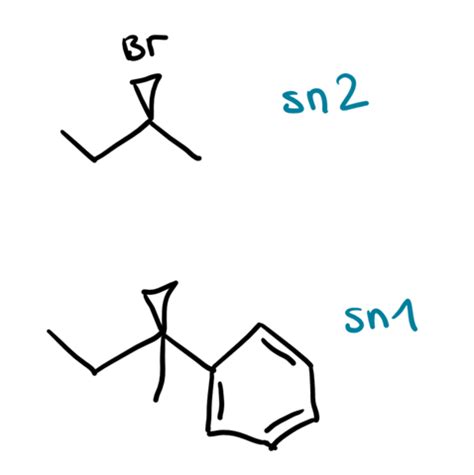Sn1 Vs Sn2

The realm of organic chemistry is replete with intricate mechanisms and reactions, each with its unique characteristics and conditions. Among these, the SN1 and SN2 reactions stand out as fundamental processes in nucleophilic substitution, differing significantly in their mechanisms, kinetics, and stereochemical outcomes. Understanding the nuances of these reactions is crucial for predicting and controlling the synthesis of complex molecules, a skill that underscores the expertise of organic chemists.
Nucleophilic Substitution Reactions: An Overview

Nucleophilic substitution reactions involve the replacement of a leaving group in an organic compound by a nucleophile. These reactions are pivotal in organic synthesis, allowing for the introduction of new functional groups into molecules. The SN1 and SN2 reactions are two primary types of nucleophilic substitution mechanisms, classified based on their kinetic behavior and the nature of the transition state.
SN1 Reaction Mechanism
The SN1 reaction, also known as the unimolecular nucleophilic substitution, proceeds through a two-step mechanism. The first step involves the departure of the leaving group from the substrate, resulting in the formation of a carbocation intermediate. This step is rate-determining and unimolecular, hence the name SN1. The carbocation, being an electron-deficient species, is highly reactive and can undergo rearrangements if the molecule is suitably structured. In the second step, the nucleophile attacks the carbocation to form the substitution product. Due to the planar nature of the carbocation, the nucleophile can approach from either side, leading to a racemic mixture if the substrate is chiral.
| Characteristic | SN1 Reaction |
|---|---|
| Rate-Determining Step | Formation of carbocation |
| Kinetics | First-order |
| Stereochemistry | Racemization |
| Substrate | Tertiary > secondary > primary |

SN2 Reaction Mechanism
In contrast, the SN2 reaction, or bimolecular nucleophilic substitution, occurs in a single step. The nucleophile attacks the carbon atom bearing the leaving group from the backside, resulting in the simultaneous departure of the leaving group and the formation of the new bond. This concerted mechanism is characterized by a transition state with a trigonal bipyramidal geometry, where the nucleophile and the leaving group are at opposite corners. The SN2 reaction is stereospecific, leading to inversion of configuration at the reaction center, a phenomenon known as the Walden inversion.
| Characteristic | SN2 Reaction |
|---|---|
| Rate-Determining Step | Nucleophilic attack |
| Kinetics | Second-order |
| Stereochemistry | Inversion of configuration |
| Substrate | Primary > secondary > tertiary |
Factors Influencing SN1 and SN2 Reactions

Several factors can influence whether an SN1 or SN2 reaction occurs, including the nature of the substrate, the nucleophile, the leaving group, and the solvent. Tertiary substrates, due to their stability as carbocations, favor SN1 reactions, whereas primary substrates, being less stable as carbocations, are more likely to undergo SN2 reactions. Strong nucleophiles and good leaving groups can also shift the balance towards one mechanism over the other.
Solvent Effects
The choice of solvent can significantly affect the reaction pathway. Polar protic solvents, such as water or alcohols, can stabilize the carbocation intermediate, favoring SN1 reactions. In contrast, polar aprotic solvents, like dimethylformamide (DMF) or dimethyl sulfoxide (DMSO), do not stabilize carbocations as effectively and are more conducive to SN2 reactions due to their ability to solvate the nucleophile and reduce its nucleophilicity.
Key Points
- The SN1 reaction proceeds through a carbocation intermediate, leading to racemization of the product.
- The SN2 reaction is a concerted process with inversion of configuration at the reaction center.
- The choice of substrate, nucleophile, leaving group, and solvent can influence whether an SN1 or SN2 reaction occurs.
- Understanding the mechanisms of SN1 and SN2 reactions is crucial for predicting and controlling the outcome of nucleophilic substitution reactions.
- The distinction between SN1 and SN2 reactions has significant implications for organic synthesis, allowing for the targeted introduction of new functional groups into molecules.
Conclusion and Future Perspectives
In conclusion, the SN1 and SN2 reactions represent two fundamental mechanisms of nucleophilic substitution, each with its unique characteristics and requirements. The ability to predict and control these reactions is a hallmark of expertise in organic chemistry, enabling the synthesis of complex molecules with precision. As organic synthesis continues to evolve, understanding the nuances of SN1 and SN2 reactions will remain essential for the development of new methodologies and the efficient synthesis of target compounds.
What is the primary difference between SN1 and SN2 reactions in terms of mechanism?
+The primary difference lies in the mechanism: SN1 reactions proceed through a two-step mechanism involving a carbocation intermediate, while SN2 reactions occur in a single, concerted step with a backside nucleophilic attack.
How do the reaction conditions influence the choice between SN1 and SN2 mechanisms?
+Reaction conditions such as the nature of the substrate, nucleophile, leaving group, and solvent can influence the choice between SN1 and SN2 mechanisms. For instance, polar protic solvents favor SN1 reactions, while polar aprotic solvents favor SN2 reactions.
What are the stereochemical outcomes of SN1 and SN2 reactions?
+SN1 reactions typically lead to racemization due to the planar nature of the carbocation intermediate, while SN2 reactions result in inversion of configuration at the reaction center due to the backside nucleophilic attack.



